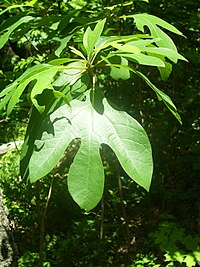
Photo from wikipedia
The redbay ambrosia beetle, Xyleborus glabratus Eichhoff, is native to Southeast Asia, where it specializes on Lauraceae trees. It forms a symbiosis with the ambrosia fungus Raffaelea lauricola T.C. Harr.,… Click to show full abstract
The redbay ambrosia beetle, Xyleborus glabratus Eichhoff, is native to Southeast Asia, where it specializes on Lauraceae trees. It forms a symbiosis with the ambrosia fungus Raffaelea lauricola T.C. Harr., Fraedrich & Aghayeva, which can act as a pathogen in living host trees. The beetle and fungus were recently introduced into the United States, where they have killed millions of native Lauraceae trees and threaten the avocado industry. These introduced populations have limited genetic variation. In the native range, the fungi are genetically variable, but the native genetic variability of the beetles is unknown. It is important to assess the beetle's native genetic variation because different lineages may vary in the capacity to vector this fungus, which may affect disease etiology. Here, we analyzed genetic variation in several Chinese, Taiwanese, and Vietnamese populations of X. glabratus using mitochondrial (COI) and nuclear DNA (CAD) markers. Phylogenetic analysis revealed nine COI haplotypes and four CAD genotypes. Uncorrected 'p' distance for intrapopulation comparisons ranged from 0 to 0.1 and 0 to 0.013 and interpopulation comparisons ranged from 0.137 to 0.168 and 0.015 to 0.032 for COI and CAD, respectively. Two populations exceeded the range of intraspecific nucleotide differences for both genes. Given that individuals from these populations also exhibited consistent morphological differences, they are described as two new species: Xyleborus insidiosus Cognato & Smith, n. sp. and Xyleborus mysticulus Cognato & Smith, n. sp. Xyleborus glabratus was redescribed and a lectotype was designated to facilitate its recognition in light of these new species. These results indicate that X. glabratus is genetically variable and is related to two morphologically similar species. Whether these new species and X. glabratus lineages associate with different fungal strains is unknown. Given that the biology and host colonization of these new species are unknown, preventing their introduction to other regions is prudent.
Journal Title: Journal of economic entomology
Year Published: 2019
Link to full text (if available)
Share on Social Media: Sign Up to like & get
recommendations!